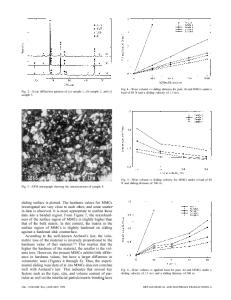Fracture behavior of Al 2 O 3 /SiC-platelet composites
- PDF / 461,968 Bytes
- 8 Pages / 612 x 792 pts (letter) Page_size
- 54 Downloads / 418 Views
MATERIALS RESEARCH
Welcome
Comments
Help
Fracture behavior of Al2 O3y SiC-platelet composites M. Belmonte, J. S. Moya, and P. Miranzo Instituto de Cer´amica y Vidrio, C.S.I.C, 28500 Arganda del Rey, Madrid, Spain
D. Nguyen, J. Dubois, and G. Fantozzi GEMPPM, URA CNRS 341-INSA de Lyon, 20 Av. A. Einstein, 69921 Villeurbanne Cedex, France (Received 30 March 1995; accepted 27 June 1996)
Mechanical behavior of hot-pressed SiC platelet reinforced alumina composites has been analyzed as a function of SiC platelet content for two different alumina matrix powders. Fracture toughness and flexural strength at temperatures ranging from 25 to 1200 ±C, R-curve behavior, and thermal shock resistance have been determined. Small differences in the impurity content of the starting Al2 O3 powders strongly determine the microstructure and the mechanical behavior of Al2 O3ySiC-platelet composites. Low alkali content alumina led to composites with large matrix grain size which presented spontaneous microcracking. At high temperature, a high viscosity liquid phase is formed that shields cracks enhancing mechanical properties and R-curve behavior. A small amount of impurities reduced Al2 O3 matrix grain size and avoided spontaneous microcracking. Enhanced fracture toughness (up to 30%) at room temperature, R-curve behavior, and thermal shock resistance were achieved for these materials.
I. INTRODUCTION
Ceramic matrix composites are increasingly considered as good candidates for cutting tools and structural applications due to their good oxidation and thermal shock resistance, low thermal expansion coefficient, and retention of high strength up to 1000 ±C. Many authors have reported substantial improvement in the mechanical properties of Al2 O3ySiCw composites,1–10 obtaining values as high as 9 MPa m1/2 and 800 MPa for fracture toughness and flexural strength, respectively. Moreover, this increase in mechanical properties is maintained up to 1000 ±C. Porter et al.4 have shown that the creep rate of alumina at 1500 ±C could be reduced two orders of magnitude with the addition of 15 wt. % of whiskers. However, the handling of whiskers produces a serious risk to health11 and, in addition, sintering of these composites usually requires high temperature treatments in a hot-pressing furnace at 1700–1800 ±C. For these reasons, some investigations have been performed in order to replace SiC whiskers by other reinforcements such as platelets. Up to date, there are few papers devoted to the study of the mechanical behavior of ceramic platelet composites,12-19 and none of them performs a complete mechanical characterization at high temperature. It has been reported that the addition of SiC platelets (30 vol. %) into an alumina matrix leads to ,30% increase on toughness and to a flexural strength reduction of a similar fraction, from ,550 MPa to ,300 MPa.12,13 Higher values of KIC and sf , 7 MPa m1/2 and 480 MPa, respectively, have been described by Chou and Green.19 2528
http://journals.cambridge.org
J. Mater. Res., Vol. 11, No. 10, Oct 19
Data Loading...











